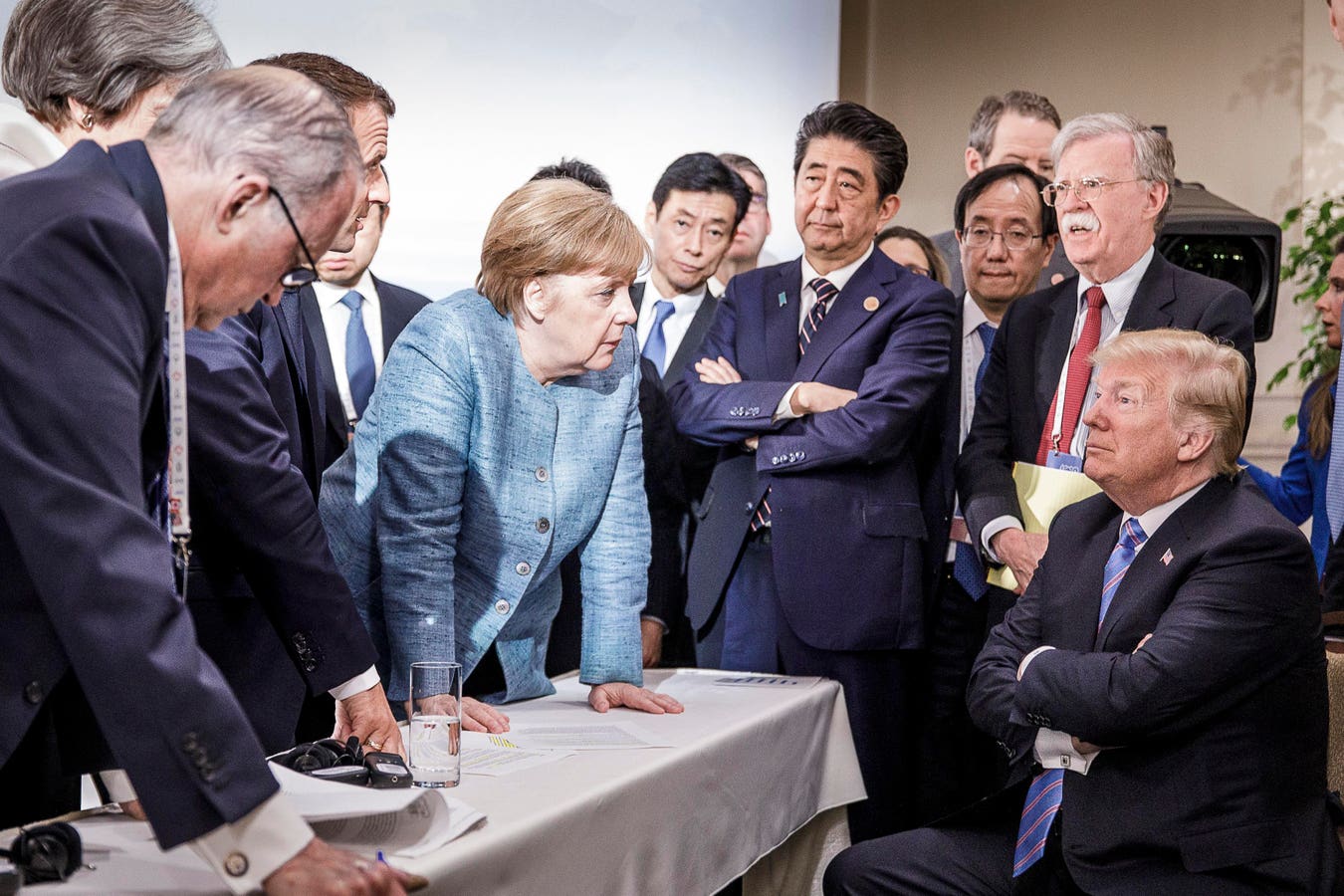CHARLEVOIX, CANADA – JUNE 9: In this photo provided by the German Government Press Office (BPA), … More
London Climate Action Week is set to start, showcasing what urgent, inclusive climate action looks like when cities, financiers, and citizens unite. But the energy and innovation on display in London are being overshadowed by growing inaction from global leaders. Just days after the G7 failed to deliver any meaningful policy progress, and as the EU backpedals on its green regulation agenda, a troubling gap is emerging between local ambition and failures of international leadership.
This retreat is happening at the worst possible moment. Climate damage costs are skyrocketing, climate science is sounding red alerts, and economic evidence points to a clear win: green investment can grow economies, create jobs, and protect communities. The world’s most powerful leaders are not just missing an opportunity, they are magnifying a crisis. To grasp its scale, we need to look at the growing economic cost of inaction.
The Price Of Delay And The Need For Leadership
Bloomberg Intelligence has estimated that in the year to May 2025, the U.S. incurred close to $1 trillion (or around 3% of GDP) in direct climate-related costs from floods, wildfires, infrastructure damage, and insurance losses.
Globally, heatwaves, droughts, and extreme weather are disrupting supply chains, inflating food prices, and undermining financial stability. Insurers have seen annual catastrophe losses surge tenfold since the 1980s. Premiums have skyrocketed, and coverage has shrunk, especially in wildfire and storm prone regions, exacerbating economic disruption and housing unaffordability.
At the same time, the European Union appears to be shelving the Green Claims Directive, retreating under political pressure precisely when markets are demanding clear, consistent regulation to guide sustainable investment. This uncertainty discourages capital and undermines momentum.
These setbacks comes as the OECD’s 2025 Green Growth report shows that climate action could unlock $7.4 trillion per year in investment and job creation if scaled by 2030. Yet rather than harnessing this opportunity, many leaders are hesitating. Nowhere is this hesitancy more evident than in the recent action, or inaction, of the G7, whose decisions ripple far beyond their border
G7 Paralysis And The Global Ripple Effect
The G7’s latest Chair’s Summary reaffirms familiar goals, like limiting warming to 1.5°C but offered no timelines, targets, or tools to achieve it. “Once again, the G7 chose safe, business-as-usual declarations over the bold, future-proof action we urgently need,” said Daniela Fernandez, CEO of Sustainable Ocean Alliance.
“The G7’s latest climate commitments reflect a deeper issue,” added Ibrahim AlHusseini, managing partner of climate investor FullCycle. “Global leaders are increasingly distracted by immediate geopolitical crises, and climate, still perceived as a medium to long-term risk, has slipped down the agenda. But this is a dangerous miscalculation.”
He added: “Delay is not neutral, it’s an accelerant of future instability,” with direct consequences for supply chains, migration, and global financial systems.
And it’s not just experts calling for change. According to the 2024 People’s Climate Vote, 80% of people globally want their countries to strengthen climate commitments, and over two-thirds support a fast transition from fossil fuels. Other surveys echoes this: 89% of people across 125 countries support stronger government action, yet many mistakenly believe they are in the minority. This public mandate for bold climate action stands in sharp contrast to the political hesitancy now on display.
As political will may be stalling, another sector is responding. What was once viewed as an environmental issue is now a pressing financial risk.
Climate Risk Becomes Financial Risk
Inaction is not just costly, it is destabilizing. The financial consequences are already unfolding across insurance markets and beyond. “We have already seen residential and commercial insurance premiums rise and availability drop in recent years, in response to growing insurer losses,” warns Tom Sabetelli-Goodyer, vice-president of climate risk at FIS. They are early signs of a broader, systemic threat. As climate impacts intensify, they are cascading through the financial system, affecting asset valuations, credit risk, and the stability of entire markets.
Regulators around the world have begun to integrate climate risk into their frameworks, but last week, the Basel Committee on Banking Supervision, the global standard-setter for financial regulation, added its voice with a new framework for the voluntary disclosure of climate-related financial risks. While non-binding, the guidance marks a significant step and reinforces a clear message: climate risk is no longer just environmental, it’s financial. As Julia Symon, head of research and advocacy at Finance Watch put it: “Without clear, consistent data, supervisors are flying blind, unaware of the real risks building up on balance sheets.”
The Climate Clock Is Ticking
Scientific indicators confirm the urgency and the danger of delay. The 2024 Indicators of Global Climate Change report shows that the average global temperature from 2015 to 2024 reached 1.24°C above pre-industrial levels, with human activity responsible for nearly all of it.
In 2024 alone, global temperatures spiked to 1.52°C, temporarily crossing the critical 1.5°C threshold. More troubling still, human-induced warming is accelerating at an unprecedented rate of 0.27°C per decade, the fastest rate ever recorded.
At current emissions levels, the remaining carbon budget for staying below 1.5°C could be fully exhausted within just two to five years, depending on assumptions. Scientists also point to a growing Earth energy imbalance and early signs of amplifying climate feedback loops, such as ocean heat uptake and ice melt, which could further lock in extreme changes.
The window for keeping global heating within safe limits is narrowing quickly. Yet even as time runs short, the economic case for prompt action continues to strengthen. Green growth offers a rare convergence of climate responsibility and financial return.
Green Growth: A Trillion-Dollar Opportunity
The OECD Green Growth report emphasizes that investing in clean energy and green infrastructure is not just responsible, its smart economics. Clean energy investment now outpaces fossil fuels, and 90% of global GDP is covered by net-zero targets. The report outlines how aligning financial systems with climate goals could unlock $7.4 trillion annually in investment by 2030.
“Green growth is an approach that seeks to harmonize economic growth with environmental sustainability and helps to deliver broader development benefits,” explains Jennifer Baumwoll, head of climate strategies and policy at UNDP.
Far from hindering development, the green transition can generate resilient jobs, improve productivity, and enhance long-term competitiveness. In short, the report argues that climate action is not a cost but a catalyst for growth.
Countries like Mongolia and Lao PDR are already demonstrating what this looks like in practice. In Mongolia, a green finance strategy, backed by the Central Bank and a new SDG-aligned taxonomy, has mobilized $120 million in climate-aligned investment, including the country’s first green bond. Green lending is targeted to grow from 2% to 10% of all bank lending by 2030.
Meanwhile, Lao PDR is advancing a national circular economy roadmap to reduce waste and resource use while unlocking economic opportunity. If fully implemented, it could create 1.6 million jobs and add $16 billion to GDP by 2050.
These pragmatic, investment-ready models of climate action deliver real development gains. Their progress underscores a growing global divide: while emerging economies embrace opportunity, many developed nations are falling behind, precisely when their leadership is most needed.
A Shrinking Window And Defining Test Of Leadership
2025 marks a critical juncture. Countries are expected to submit new national climate plans (NDCs 3.0) ahead of COP30 in Belém this November. Yet as of late June 2025, four months after the February deadline, only a small fraction had done so. Intended to reflect increased ambition following the Global Stocktake, most submissions remain overdue, and the ambition gap continues to widen.
The UN expects a surge of last-minute filings, but tardiness isn’t the only concern. Most existing plans fall short of aligning with the 1.5°C target, and the policy frameworks to deliver them at scale are still lacking. The challenge is not technical though but political.
Instead of advancing, many major economies are retreating, weakening targets, delaying regulations, and rolling back commitments just as the case for bold action becomes stronger.
Evidence shows that a well-managed transition can boost growth, reduce inequality, and build resilience. Yet that potential is being squandered. What’s needed now is not just political courage, but real leadership, capable of driving structural reform and aligning finance with planetary boundaries.
Decisive action today isn’t only about avoiding catastrophe, it’s about exercising leadership that can shape a more stable, equitable, and liveable world. The responsibility lies with those in power to act—not later, but now.









